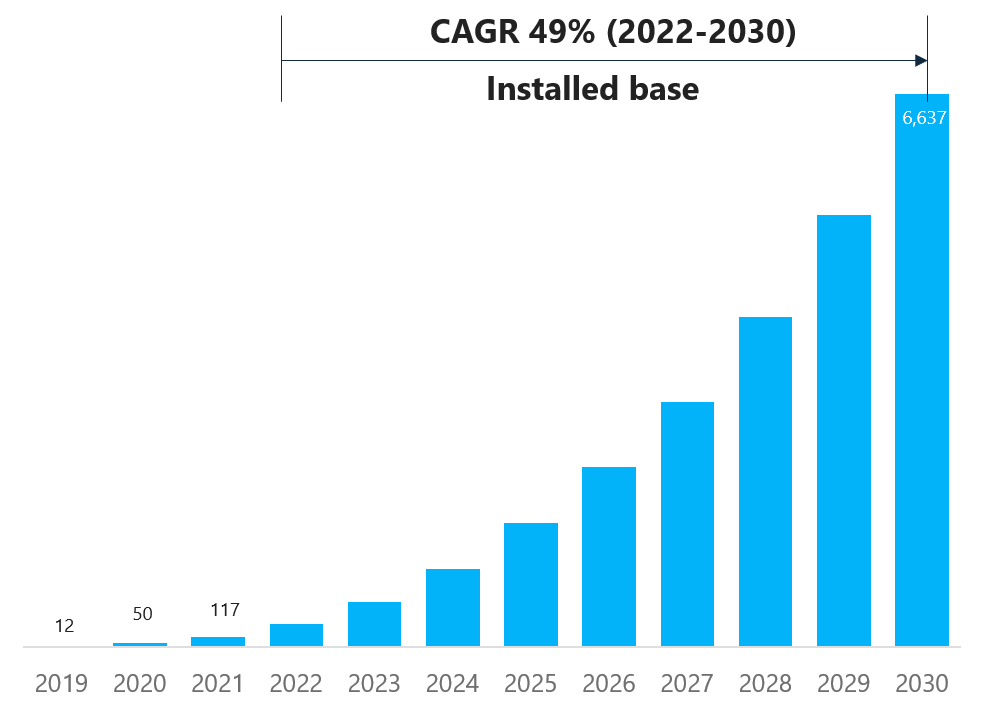Analyst firm foresees global micro-fulfillment center market topping 6,600 installs by 2030
Study by LogisticsIQ estimates rapid growth for micro-fulfillment center automation solutions and services through 2030.

The market for micro-fulfillment center (MFC) solutions is expected to grow rapidly, according to research on automated MFCs by analyst firm LogisticsIQ, driven by rising ecommerce volumes, the changing geographical nature of e-commerce demand, and the growing desire for same-day or same-hour delivery. The firm’s latest round of MFC market research concludes the MFC market will have a cumulative opportunity worth more than $36 billion within the next 10 years, and by 2030, an installed base estimated at approximately 6,600 sites or locations which could be considered MFCs.
“Year 2022 & 2023 are going to be the cornerstone for Micro Fulfillment market touching a billion-dollar mark and setting the base for the future,” stated Avi Gupta, LogisticsIQ Lead Analyst. “It is expected to have more than $6 billion annual market revenue of micro-fulfillment automation from grocery omnichannel (spanning companies such as Walmart, Kroger, Ocado, Tesco, Albertsons, Meijer, Ahold Delhaize, Target, Carrefour) and pure-play ecommerce players (including Amazon, Gopuff, Instacart, Grofers, Missfresh, Dingdong) only by 2030.”
The third edition of this study is a market analysis of more than 250 players (part of the firm’s Market Map), key technologies, targeted warehouse sizes, end-user Industries, store types and more than 20 countries/regions. The analysis is validated through 50-plus i interviews across the value chain with components and technology providers, system integrators & manufacturers, grocery stores and end-user industry verticals, the firm added.
Among key points the research highlights:
- Annual MCF installations will grow at a compound annual growth rate (CAGR) of 49% through 2030, from a current installed base of more than 50 MFCs in 2020 but expected to top 6600 installs during 2030.
- More than 80% of these micro fulfilment centers will be deployed in North America in 2022.
- The MFC services itself will contribute more than $1.6 billion by 2030 in this emerging space.
- Almost 65% installation are supposed to be deployed with shuttle-based and cube-storage technologies in 2030, led by AutoStore and Takeoff Technologies. Players with solutions based on autonomous mobile robots (AMR) are also expected to be significant part of the market.
- LogisticsIQ has forecasted more than 1000 MFC installation for In-store deployment and over 380 installations of “dark stores” in 2030, although the latter might encompass some installations within existing or new DCs/fulfillment centers as well.
- More than 50% of such MFC installations are expected to be targeted for warehouses having a size of between 5000 sq. ft. and 25,000 sq. ft., though also good growth for locations with less than 5000 sq. ft., with growth in this segment due to new dark stores opened by ultrafast delivery players.
- LogisticsIQ foresees the US market as being main MFC market over the next 10 years, followed by U.K., Japan, France and China. It also expects around 3400 of the MFC install base or locations, just over 50% of worldwide market, to be within the US by 2030.
“It is estimated that online grocery will contribute more than 10% of overall grocery sales in US by 2025, as consumers will continue with the habit developed during the pandemic,” said Leena Mittal, consulting specialist at LogisticsIQ. “Delivery options may vary [to include] home delivery, in-store pick up, curb-side pickup, or locker delivery. Urban warehouses with automation will be key to meet this demand with same day delivery expectations, although delivery fee is the one of the key factors to decide the digital channel in the long term. The main key is to make the online grocery business more profitable as compared to current scenario of either net loss or thin profit margin.”

Article Topics
News & Resources
USPS cites continued progress in fiscal second quarter earnings despite recording another net loss U.S. rail carload and intermodal volumes are mixed, for week ending May 4, reports AAR New Ryder analysis takes a close look at obstacles in converting to electric vehicles Norfolk Southern shareholders sign off on 10 board of directors nominees Inflation and economic worries are among top supply chain concerns for SMBs Port Tracker report is bullish on import growth over the balance of 2024 Varying opinions on the tracks regarding STB’s adopted reciprocal switching rule More NewsLatest in Logistics
Key benefits of being an Amazon Business customer with Business Prime USPS cites continued progress in fiscal second quarter earnings despite recording another net loss U.S. rail carload and intermodal volumes are mixed, for week ending May 4, reports AAR New Ryder analysis takes a close look at obstacles in converting to electric vehicles Norfolk Southern shareholders sign off on 10 board of directors nominees Between a Rock and a Hard Place Inflation and economic worries are among top supply chain concerns for SMBs More LogisticsSubscribe to Logistics Management Magazine

Find out what the world's most innovative companies are doing to improve productivity in their plants and distribution centers.
Start your FREE subscription today.
May 2024 Logistics Management

Latest Resources














